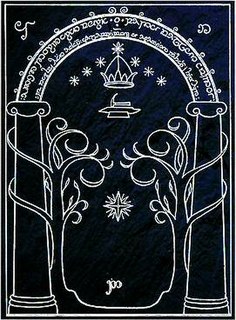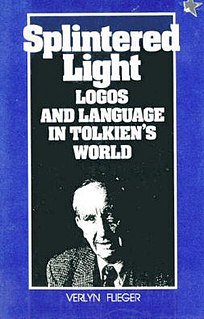Related Research Articles

"Leaf by Niggle" is a short story written by J. R. R. Tolkien in 1938–39 and first published in the Dublin Review in January 1945. It can be found, most notably, in Tolkien's book titled Tree and Leaf, and in other places. This is notable because the book, consisting of a seminal essay called "On Fairy-Stories" and "Leaf by Niggle", offers the underlying philosophy of much of Tolkien's fantastical writings.
Eärendil the Mariner and his wife Elwing are characters in J. R. R. Tolkien's Middle-earth legendarium. They are depicted in The Silmarillion as Half-elven, the children of Men and Elves. He is a great seafarer who, on his brow, carried the morning star, a jewel called a Silmaril, across the sky. The jewel had been saved by Elwing from the destruction of the Havens of Sirion. The morning star and the Silmarils are elements of the symbolism of light, for divine creativity, continually splintered as history progresses. Tolkien took Eärendil's name from the Old English Earendel, found in the poem Crist A, which hailed him as "brightest of angels"; this was the beginning of Tolkien's Middle-earth mythology. Elwing is the granddaughter of Lúthien and Beren, and is descended from Melian the Maia. Through their progeny, Eärendil and Elwing became the ancestors of the Númenorean, and later Dúnedain, royal bloodline.
The Ainulindalë is the creation account in J. R. R. Tolkien's legendarium, published posthumously as the first part of The Silmarillion (1977).
Finwë and Míriel are fictional characters from J. R. R. Tolkien's legendarium. Finwë, sometimes surnamed Noldóran, is the first King of the Noldor to lead his people on the journey from Middle-earth to Valinor in the blessed realm of Aman. Míriel was the first wife of Finwë, who died while giving birth to their only child Fëanor, creator of the Silmarils; her spirit would later serve the Vala queen Vairë as a historian.

Elu Thingol or Elwë Singollo is a fictional character in J.R.R. Tolkien's Middle-earth legendarium. He appears in The Silmarillion, The Lays of Beleriand and The Children of Húrin and in numerous stories in The History of Middle-earth. Depicted as the King of Doriath, King of the Sindar, High-king and Lord of Beleriand, he is a major character in the First Age of Middle-earth and an essential part of the ancestral backgrounding of the romance between Aragorn and Arwen in The Lord of the Rings.
The Notion Club Papers is an abandoned novel by J. R. R. Tolkien, written during 1945 and published posthumously in Sauron Defeated, the 9th volume of The History of Middle-earth. It is a time travel story, written while The Lord of the Rings was being developed. The Notion Club is a fictionalization of Tolkien's own such club, the Inklings.
Ælfwine the mariner is a fictional character found in various early versions of J. R. R. Tolkien's Legendarium. Tolkien envisaged Ælfwine as an Anglo-Saxon who visited and befriended the Elves and acted as the source of later mythology. Thus, in the frame story, Ælfwine is the stated author of the various translations in Old English that appear in the twelve-volume The History of Middle-earth edited by Christopher Tolkien.

In J. R. R. Tolkien's legendarium, the history of Arda, also called the history of Middle-earth, began when the Ainur entered Arda, following the creation events in the Ainulindalë and long ages of labour throughout Eä, the fictional universe. Time from that point was measured using Valian Years, though the subsequent history of Arda was divided into three time periods using different years, known as the Years of the Lamps, the Years of the Trees and the Years of the Sun. A separate, overlapping chronology divides the history into 'Ages of the Children of Ilúvatar'. The first such Age began with the Awakening of the Elves during the Years of the Trees and continued for the first six centuries of the Years of the Sun. All the subsequent Ages took place during the Years of the Sun. Most Middle-earth stories take place in the first three Ages of the Children of Ilúvatar.
Mythopoeia —or mythopoesis (μυθοποίησις)—is a narrative genre in modern literature and film where a fictional or artificial mythology is created by the writer of prose or other fiction. This meaning of the word follows its use by J. R. R. Tolkien in the 1930s. The authors in this genre integrate traditional mythological themes and archetypes into fiction. Mythopoeia is also the act of creating myth.
Tolkien's legendarium is the body of J. R. R. Tolkien's mythopoeic writing, unpublished in his lifetime, that forms the background to his The Lord of the Rings, and which his son Christopher Tolkien summarized in his compilation of The Silmarillion and documented in his 12-volume series The History of Middle-earth. The legendarium's origins date back to 1914, when he began writing poems and story sketches, drawing maps, and inventing languages and names as a private project to create a unique English mythology. The earliest story drafts are from 1916; he revised and rewrote these for most of his adult life.
Verlyn Flieger is an author, editor, and Professor Emerita in the Department of English at the University of Maryland at College Park, where she taught courses in comparative mythology, medieval literature, and the works of J. R. R. Tolkien. She is well known as a Tolkien scholar, especially for her books Splintered Light and A Question of Time. She has won the Mythopoeic Scholarship Award four times for her work on Tolkien's Middle-earth writings.
The Ainur (singular: Ainu) are the immortal spirits existing before Creation in J. R. R. Tolkien's fictional universe. These were the first beings made of the thought of Eru Ilúvatar. They were able to sing such beautiful music that the world was created out of it.
Morgoth Bauglir is a character, one of the godlike Valar, from Tolkien's legendarium. He is the main antagonist of The Silmarillion, The Children of Húrin, and The Fall of Gondolin.

The Silmarillion is a collection of mythopoeic stories by the English writer J. R. R. Tolkien, edited and published posthumously by his son Christopher Tolkien in 1977 with assistance from the fantasy author Guy Gavriel Kay. The Silmarillion tells of Eä, a fictional universe that includes the Blessed Realm of Valinor, the once-great region of Beleriand, the sunken island of Númenor, and the continent of Middle-earth, where Tolkien's most popular works—The Hobbit and The Lord of the Rings—are set. After the success of The Hobbit, Tolkien's publisher Stanley Unwin requested a sequel, and Tolkien offered a draft of the stories that would later become The Silmarillion. Unwin rejected this proposal, calling the draft obscure and "too Celtic", so Tolkien began working on a new story that eventually became The Lord of the Rings.
Christianity is a central theme in J. R. R. Tolkien's fictional works about Middle-earth, but always a hidden one. This allows the book to be read at different levels, and its meaning to be applied by the reader, rather than forcing a single meaning on the reader.

Tolkien's artwork was a key element of his creativity from the time when he began to write fiction. The philologist and author J. R. R. Tolkien prepared illustrations for his Middle-earth fantasy books, facsimile artefacts, more or less "picturesque" maps, calligraphy, and sketches and paintings from life. Some of his artworks combined several of these elements to support his fiction.
J. R. R. Tolkien built a process of decline and fall in Middle-earth into both The Silmarillion and The Lord of the Rings.
Tolkien's monsters are the evil beings, such as Orcs, Trolls, and giant spiders, who oppose and sometimes fight the protagonists in J. R. R. Tolkien's Middle-earth legendarium. Tolkien was an expert on Old English, especially Beowulf, and several of his monsters share aspects of the Beowulf monsters; his Trolls have been likened to Grendel, the Orcs' name harks back to the poem's orcneas, and the dragon Smaug has multiple attributes of the Beowulf Dragon. The European medieval tradition of monsters makes them either humanoid but distorted, or like wild beasts, but very large and malevolent; Tolkien follows both traditions, with monsters like Orcs of the first kind and Wargs of the second. Some scholars add Tolkien's immensely powerful Dark Lords Morgoth and Sauron to the list, as monstrous enemies in spirit as well as in body. Scholars have noted that the monsters' evil nature reflects Tolkien's Roman Catholicism, a religion which has a clear conception of good and evil.

The music of Middle-earth consists of the music mentioned by J. R. R. Tolkien in his Middle-earth books, the music written by other artists to accompany performances of his work, whether individual songs or adaptations of his books for theatre, film, radio, and games, and music more generally inspired by his books.

Splintered Light: Logos and Language in Tolkien's World is an 1983 book of literary criticism by the leading Tolkien scholar Verlyn Flieger, in which she argues that light is a central theme of Tolkien's Middle-earth mythology, in particular in The Silmarillion. It has been admired by other scholars to the extent that it has become a core element of Tolkien scholarship.
References
- ↑ J. R. R. Tolkien, Tree and Leaf; Mythopoeia; The Homecoming of Beorhtnoth Beorhthelm's Son (London: HarperCollins, 2001) [first published 1964] ISBN 9780007105045.
- ↑ Merriam-Webster's Collegiate Dictionary.
- 1 2 Dundes, quoted by Adcox, 2003.
- 1 2 3 Menion, 2003/2004 citing essays by Tolkien using the words "fundamental things".
- ↑ Tolkien, J. R. R. (15 February 2012). The Silmarillion. Houghton Mifflin Harcourt. p. 10. ISBN 9780547951980.
- ↑ Tolkien, J. R. R. (21 February 2014). The Letters of J.R.R. Tolkien. Houghton Mifflin Harcourt. pp. 361, 147. ISBN 9780544363793.
- ↑ MacLeod, Jeffrey J.; Smol, Anna (2008). "A Single Leaf: Tolkien's Visual Art and Fantasy". Mythlore . 27 (1). article 10.
- ↑ Flieger, Verlyn (1983). Splintered Light: Logos and Language in Tolkien's World. Wm B. Eerdmans Publishing. pp. 44–49. ISBN 978-0-8028-1955-0.